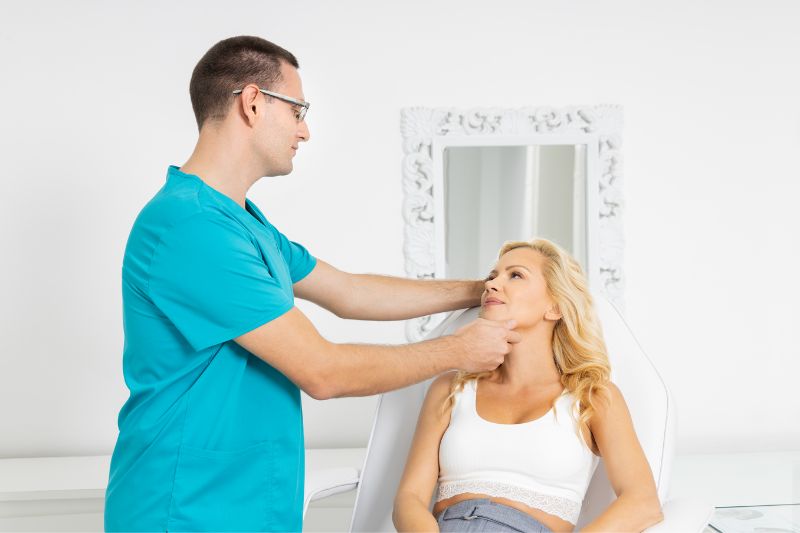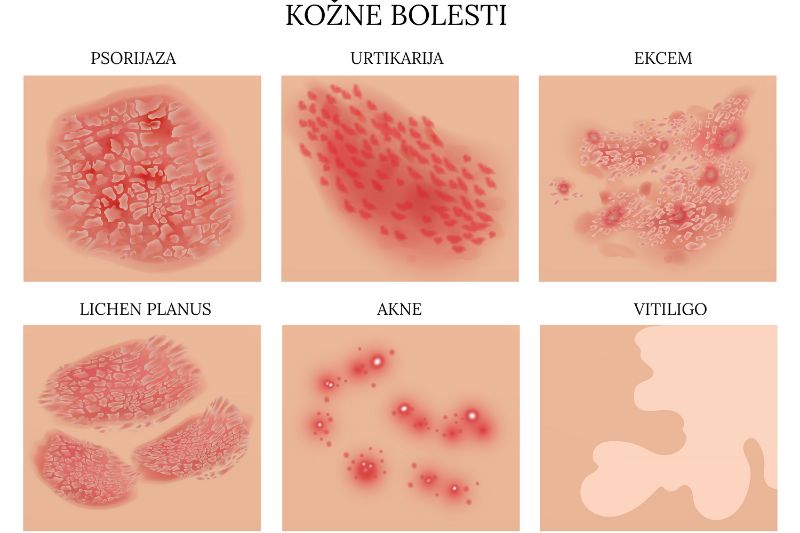Dermatologist-Belgrade.A dermatological examination is the initial step you should take when you observe specific changes in your skin or when you seek appropriate care for it. Undoubtedly, our skin deserves nothing but the best, making the selection of a dermatologist an important decision.
What does a dermatological examination entail? What can you anticipate during the examination? Is it painful or uncomfortable? What happens after the assessment? Numerous inquiries arise, and that’s precisely why we aim to address all uncertainties pertaining to the dermatological examination in a single comprehensive resource.

When should you visit a dermatologist?
Dermatology is the science that focuses on skin and skin diseases, with its name originating from the Greek words “derma” meaning skin and “logia” meaning study or science. Our skin undergoes various changes and conditions on a daily basis. Dermatology has identified and described around 2,000 different skin diseases, clinical conditions, and disorders affecting the skin and mucous membranes.
When we observe any noticeable changes on our skin, it is advisable to consult a dermatologist. The skin serves as a reflection of our overall health, and many health issues can manifest through skin symptoms. For instance, chronic itching can be a symptom of kidney disease, while dark lines on the nails may indicate skin cancer.
It is important to promptly seek the expertise of a dermatologist when you notice any skin changes. They will conduct a detailed examination and analysis to determine the exact nature of the issue. If necessary, they may refer you to additional examinations or specialists.
What is a dermatological examination?
It is a specialized type of examination that involves the evaluation of the skin, mucous membranes throughout the body, as well as the hair, nails, and, if necessary, the genital area. The examination is conducted by a dermatologist, a medical professional specialized in the diagnosis, treatment, and prevention of skin, mucous membrane, hair, and nail diseases.
Regardless of the skin issue you are facing, we strongly advise against waiting for the symptoms to resolve on their own. Instead, it is crucial to seek the expertise of a dermatologist as soon as possible.
When scheduling an appointment with a dermatologist in Belgrade or any other city, it is important not to make a random choice based solely on internet information. Prior to making a decision, conduct thorough research, verify the qualifications of the doctor you intend to visit, and ascertain their level of professionalism and experience. Being well-informed and equipped with all the necessary facts before undergoing a dermatological examination is essential.
What does a dermatological examination include?
The dermatologist begins with a comprehensive patient interview to establish personal and family medical history. The patient describes their presenting issue, symptoms, and any previous skin conditions or family history of skin problems or other diseases. The doctor asks a series of questions to determine medication use and current therapies. It is important to openly communicate any relevant information without hesitation or fear.
Next, the dermatologist reviews any existing medical records, if available, and proceeds with the dermatological examination itself. The examination involves visual observation with the naked eye or with aids such as magnifying glasses, light lamps, or dermatoscopes. A dermatoscope with measuring divisions and light may be used to examine pigmented and non-pigmented skin changes. If there is suspicion of high-risk changes, a dermoscopic camera may be utilized. In cases of suspected fungal infections, a Wood’s lamp examination may be performed. Following the examination, the dermatologist provides a final opinion, establishes a diagnosis, and prescribes treatment or additional tests if necessary.
In situations where the examination alone is insufficient for diagnosis, further steps may be required. This can include laboratory tests such as blood and urine analyses. Microbiological analyses are conducted when there is suspicion of fungal, bacterial, or viral infections. A small sample of skin or hair is collected for analysis to identify the presence of specific bacteria, viruses, or fungi. In rare cases, a skin biopsy may be necessary to determine the diagnosis. A small skin sample is taken under local anesthesia and sent for analysis. Based on the results, the dermatologist will establish a diagnosis or refer the patient to other specialists (such as internists, cardiologists, hematologists, etc.) for further examinations.
The most common reasons for seeking a dermatologist’s care
Going to a dermatologist is most often prompted by changes in the skin or worsening of chronic skin conditions. Symptoms can range from mild to severe and may affect the skin, mucous membranes, and genital area, requiring long-term treatment and therapy.
Common reasons for visiting a dermatologist include:
- Rashes, redness, and allergies on the face and body.
- Tightening, itching, and peeling of the skin.
- Conditions such as rosacea, vitiligo, lentigo, atopic dermatitis, seborrheic dermatitis, psoriasis, urticaria (hives), and melasma.
- Athlete’s foot and fungal skin diseases.
- Acne and pimples, which affect a significant portion of the population and can lead to excessive oiliness, sebum production, and acne scars.
- Pigmentation and spots resulting from sun exposure (photopigmentation) and sun-related skin diseases (photodermatoses).
- Changes and injuries on moles.
- Keratoses and warts.
- Impetigo, a contagious bacterial infection characterized by red sores, blisters, and scabs.
- Hair loss (alopecia) and scalp flaking.
- Suspected sexually transmitted diseases such as herpes, genital warts, chlamydia, and syphilis.
These conditions represent only a fraction of what dermatologists successfully treat. Additionally, dermatologists can provide advice on proper skin care and recommend aesthetic treatments tailored to your age, skin type, and condition, improving skin quality, tone, and appearance while preventing premature aging.

Examination
It is important for you to approach the examination in a relaxed and fearless manner. The dermatologist should help you further relax and gather all the necessary information about your condition and potential causes through a calm conversation. A friendly and compassionate approach to patients is crucial, as many patients often come in with fear, various anxieties, and doubts about serious diseases. Therefore, it is important to carefully choose a dermatologist in Belgrade who can meet all your expectations. The duration of the examination itself typically ranges from 20 to 30 minutes, depending on the patient’s condition and the nature of the issue being addressed. A dermatological examination is completely painless. As mentioned earlier, if a skin biopsy is necessary, the procedure is performed under local anesthesia and does not cause any discomfort.
Does a dermatological examination require any product?
No, a dermatological examination does not require any specific product from the patient. However, if you have a problem with your face, it is recommended to come to the examination without wearing makeup.
It would also be helpful to write down on paper any information you believe is important for the doctor to know, so that you don’t forget to mention it. This can include:
- A list of all your symptoms, no matter how insignificant they may seem to you. Make sure to mention all of them to the dermatologist.
- The duration of the problem and whether you have experienced similar issues before.
- Any occurrence of itching, pain, or bleeding, and how frequently they happen.
- Inform the dermatologist about any previous therapies you have undergone and whether they were effective.
- If you use any dietary supplements or beauty products, make a list of them to share with the dermatologist.

What happens after a dermatological examination?
Therapy may include medications, treatments, or creams that can improve the condition. The date for a check-up examination is determined in agreement with the dermatologist. The dermatologist provides clear advice and instructions, suggesting preventive measures such as modifying the diet, reducing stress, exercising regularly, and avoiding alcohol and cigarettes. They also offer advice on skincare, recommending the use of specific dermatological creams to improve the current condition of the skin. The dermatologist closely monitors the patient’s condition and makes any necessary changes or adjustments to the therapy. In certain cases, the dermatologist may recommend additional procedures, including:
- Skin biopsy: a procedure to obtain a sample of skin tissue for further examination.
- Dermoscopy: an examination of moles performed when they itch, hurt, burn, change color or shape suddenly, or have irregular edges. It is also recommended for cases with more than 50 moles on the body. Preventive mole examinations once a year are advised to ensure peace of mind and rule out any concerns.
- Excision or surgical removal of suspicious moles identified during examination.
- Certain chemical peeling treatments that contribute to improving the complexion.
- Removal of warts or keratoses.
- Aesthetic treatments that can eliminate wrinkles and restore the skin’s elasticity and youthful appearance.
10 interesting facts about skin
Discover the fascinating facts of our skin:
- Our skin is the largest organ, covering an area of approximately two square meters.
- It consists of around 300 million cells.
- During extreme heat, it can release up to 11 liters of sweat per day.
- The skin undergoes a renewal process every 28 days, shedding a layer of dead cells.
- Believe it or not, discarded skin cells account for as much as a billion tons of the total dust on Earth.
- On average, the skin has a thickness of about two millimeters.
- Approximately 18 percent of our total body weight is comprised of skin.
- There are approximately 11,000 blood vessels in the skin.
- Areas of the skin that are more oily tend to have less hair.
- Specific areas such as the palms, fingertips, tongue, lips, and genitals possess highly sensitive receptors known as Meissner’s corpuscles. These receptors allow us to perceive even the lightest touches, such as the landing of a tiny wine fly weighing only 20 milligrams.
Dermatologists in Belgrade
If you require the services of a dermatologist in Belgrade, scheduling an appointment with us is simple!
It is crucial to highlight that we exclusively employ top-quality, safe, and registered products and devices for comprehensive diagnosis and treatment of all skin concerns. We offer services such as skin biopsy, mole examination, and dermatoscopy. Most importantly, our dermatologists possess extensive experience, expertise, and professionalism, which they demonstrate through their daily accomplishments. We take pride in the fact that our dermatologists come highly recommended by our patients to others.
Prices and more information?
You can see the prices on the Pricelist page. Call us at phone number 064/237-0707 or write to us at imedic.rs@gmail.com. We are here for all your doubts!


